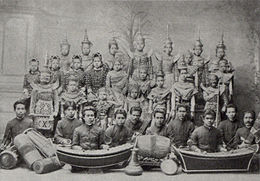Music of Thailand
The music of Thailand reflects its geographic position at the intersection of China and India, and reflects trade routes that have historically included Persia, Africa, Greece and Rome. Thai musical instruments are varied and reflect ancient influence from far afield - including the klong thap and khim (Persian origin), the jakhe (Indian origin), the klong jin (Chinese origin), and the klong kaek(Indonesian origin). Though Thailand was never colonized by colonial powers, pop music and other forms of modern Asian, Europeanand American music have become extremely influential. The two most popular styles of traditional Thai music are luk thung and mor lam; the latter in particular has close affinities with the Music of Laos.
Aside from the Thai, ethnic minorities such as the Lao, Lawa, Hmong, Akha, Khmer, Lisu, Karen and Lahu peoples have retained traditional musical forms.
Thai classical music is synonymous with those stylized court ensembles and repertoires that emerged in its present form within the royal centers of Central Thailand some 800 years ago. These ensembles, while being deeply influenced by Khmer and even older practices and repertoires from India, are today uniquely Thai expressions. While the three primary classical ensembles, the Piphat, Khrueang saiand Mahori differ in significant ways, they all share a basic instrumentation and theoretical approach. Each employ the small ching hand cymbals and the krap wooden sticks to mark the primary beat reference. Several kinds of small drums (klong) are employed in these ensembles to outline the basic rhythmic structure (natab) that is punctuated at the end by the striking of a suspended gong (mong). Seen in its most basic formulation, the classical Thai orchestras are very similar to the Cambodian (Khmer) pinpeat and mahori ensembles, and structurally similar to other orchestras found within the widespread Southeast Asian gong-chime musical culture, such as the large gamelan of Bali and Java, which most likely have their common roots in the diffusion of Vietnamese Dong-Son bronze drums beginning in the first century ACE.
Traditional Thai classical repertoire is anonymous, handed down through an oral tradition of performance in which the names of composers (if, indeed, pieces were historically created by single authors) are not known. However, since the beginning of the modern Bangkok period, composers' names have been known and, since around the turn of the century, many major composers have recorded their works in notation. Musicians, however, imagine these compositions and notations as generic forms which are realized in full in idiosyncratic variations and improvisations in the context of performance. While the composer Luang Pradit Phairau (1881–1954) used localized forms of cipher (number) notation, other composers such as Montri Tramote (1908–1995) used standard western staff notation. Several members of the Thai royal family have been deeply involved in composition, including King Prajatipok (Rama VII, 1883–1941) and King Bhumibol Adulyadej (1927–), whose compositions have been more often for jazz bands than classical Thai ensembles.
Classical Thai music is polyphonic and follows similar conventions to American Folk and Dixieland Music. Each instrument improvises within accepted idioms around basic lines of harmony or melody called paths.Rhythmically and metrically Thai music is steady in tempo, regular in pulse, divisive, in simple duple meter, without swing, with littlesyncopation (p. 3, 39), and with the emphasis on the final beat of a measure or group of pulses and phrase (p. 41), as opposed to the first as in European-influenced music. The Thai scale includes seven tempered notes, instead of a mixture of tones and semitones. Five of seven pitches are used as the principal pitches in any mode, introducing nonequidistant intervals.[1]  Play (help·info)
Play (help·info)


ไม่มีความคิดเห็น:
แสดงความคิดเห็น